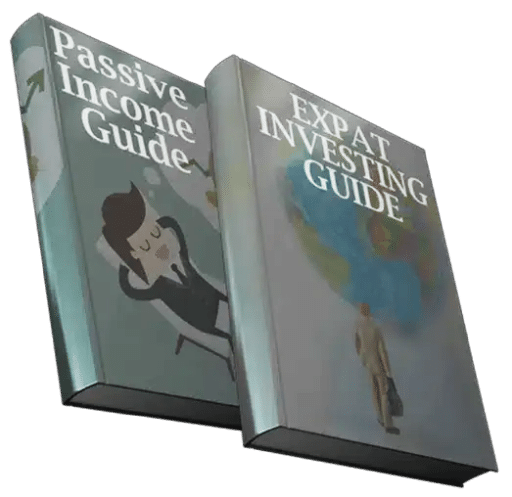In this article, we’ll compare risk vs volatility in investing.
Many people choose to grow their wealth by investing in various investment funds to achieve their financial goals.
To invest is inherently risky. Any investment you make is subject to the risk that it could lose some or all of its value as a result of fluctuations in the market.
Investors must also prepare for volatility. No asset’s value stays the same for very long, and the amount of gains and losses can shock even the most seasoned investors.
Although the terms risk and volatility are sometimes used interchangeably, they are distinct concepts. Let’s examine the similarities and contrasts between these two fundamental investment ideas.
If you want to invest as an expat or high-net-worth individual, you can email me (advice@adamfayed.com) or use these contact options.
Table of Contents
Risk vs Volatility Explained: What is Risk
The term “risk” refers to the potential for a negative financial outcome associated with an investment. Simply put, risk is the probability that an investment may decline in value.
The correlation between risk and return is one of the cornerstones of sound investment practice. Investments with a lower level of risk often provide lower returns, whereas those with higher levels of risk can potentially yield higher returns.
When there is a higher potential for financial loss, investors expect higher rewards.
The potential for financial loss is the risk that is most often described. Note that “upside risk,” which refers to the prospect of achieving a higher than-projected return on investment, is sometimes referred to by investing professionals.
Risk vs Volatility Explained: What is Volatility
Volatility is a statistical measure of an asset’s price movement dispersion. This relates to the rate, frequency, and magnitude of price fluctuations.

Consider volatility to be the risky relative. Volatility in the market presents both greater opportunity and greater risk for traders with short-term horizons. Volatility is the fuel for the gains of speculative traders.
Volatility refers to fluctuations in asset prices, not asset values, in the grand scheme of things. The distinction between cost and worth should not be overlooked.
The worth of a company can stay the same even though the price of its stock goes up and down rapidly.
The price that investors are prepared to pay to acquire that inherent value has fluctuated greatly over time and continues to do so in response to constantly shifting market conditions.
Volatility is less of a concern for long-term investors. Long-term investors often allocate a larger portion of their portfolios to equities due to the fact that short-term price movements tend to average out over time.
Shortening the time horizon and getting closer to retirement means decreasing the allocation to stock and increasing the allocation to bonds.
Although there is risk involved with bonds, their volatility is far lower than that of equities.
Why Volatility is Important for Investors
Bear markets are more volatile, which can have a direct effect on portfolios and make owners more stressed as they watch the value of their portfolios drop.
This often makes buyers buy more stocks as prices drop to rebalance their portfolios between stocks and bonds. In this way, market volatility is good for buyers because they can make money off of it.
You should know how volatile an investment is before you decide to make it. This will help you decide if it is a good fit for you.
For instance, if you’re spending the money you’ve saved for a down payment on a house and you plan to buy a house in the next year, you should probably put that money into something very stable.
You can be sure that the cash will be available when you need it.
There’s also a chance that you want to bet on an investment that could pay off big. That being said, you should probably put your money into something that changes a lot, but you should also be ready to lose it.
How Are Volatility and Risk Related in an Investment?
When assessing an investment, you should not conflate risk and volatility. While both volatility and risk are subject to fluctuate over time, volatility is more concrete and tangible than risk is typically perceived.
The daily fluctuations of the Dow Jones Industrial Average (DJIA) are one indicator of market volatility.
DJIA, an index of 30 of the top U.S. firms, hit a record high of 29,568 points in February. The ups and downs of these equities are determined by their individual merits, but the Dow measures the average.
If all 30 of these stocks start moving in the same way, the Dow Jones will lose or gain a larger amount of points, and volatility will grow.
The Dow Jones Industrial Average dropped by 2,997 points, or over 13%, on March 16. This was the greatest single-point drop in index history.
Market volatility can make investments riskier by expanding the spread of possible outcomes, although this is not always the case.
Although not suitable for the average investor, hedge funds frequently employ tactics that generate higher returns in response to rising market volatility.
Volatility assesses how much prices shift, whereas risk evaluates how likely it is that anything bad will happen.
Since stocks often take the escalators up and the elevators down, when market volatility is high, most investors lose money.
However, over a sufficiently long horizon, market fluctuations are reduced to random noise.
Is Risk and Volatility the Same?
Investment risk is commonly discussed, comprehended, and quantified by reference to volatility. To that extent, we might equate volatility with risk.
Volatility, though, is merely one of many indicators of risk. Other risk instruments and measures exist, some of which attempt to tackle the aforementioned problems.
To combat the fact that volatility can move in either direction, we can use metrics that modify the standard deviation idea or other widely used tools to reflect the unidirectionality of risk.
Value at Risk (VAR), Sortino Ratio, and downside deviation are all examples. The second issue (an underestimation of the likelihood of extreme occurrences) is still not being adequately addressed by most of them.
Maximum theoretical loss, rather than some predicted value inferred by a return distribution model you have constructed based on historical observations, is the only way to measure risk without the possibility of underestimating low-probability extreme outcomes.
A likelihood of 0.01% may seem little, but don’t let that fool you. Even though it only happens once every 10,000 years, that may be tomorrow.
Just because you can lose money investing in something risky doesn’t imply you should never invest in it.
This means that while volatility is helpful, it is not a foolproof indicator of risk and should not be used as such.
How to Manage Financial Risk
Consider getting income from more than one source. Increase your income in more than one way.
Make sure your investments are diversified. Buy stocks, bonds, and real estate, among other things, among your assets. With this, the chance is lower because even if one investment fails, the others might still do well.
Start making a plan for dealing with risks. Outline how your company will handle danger in this document. And so everyone is on the same page, it should have your company’s risk tolerance, rules, and steps.
Insure yourself with the right amount. There is a balance between not having enough insurance and having to pay for losses yourself. In your field, find the right mix.
Hire an expert in risk management. Risk can be found, evaluated, and managed with the help of these experts.
Save money for when things go wrong with your business. Prepare for a recession, pandemic, or other unplanned event by setting away six to twelve months’ worth of income to cover business costs.
Make sure you regularly look over your financial risk. There are new risks as your business grows. One time a year, make sure your risk management plan is still useful by going over it again.
How to Measure Risk
Your financial advisor can determine your risk tolerance or the amount of risk you are willing to face as an investor, in a number of different methods.
Advisors can determine your risk tolerance and current risk exposure using one of five standard methods.
Alpha
A portfolio’s alpha is its performance relative to its own risk profile, as opposed to the market’s beta or a connected benchmark.

It’s a method for determining the “excess return” on an investment or the amount by which the investment’s performance has outpaced both market expectations and the security’s or portfolio’s innate price sensitivity to market fluctuations.
Alpha is often used to evaluate active management since it reflects the excess return of a portfolio above that of a reference index. A portfolio manager’s value is best captured by his or her capacity to produce “alpha.”
Beta
The volatility of a security (such as a stock or mutual fund) is measured statistically in terms of its beta, which is compared to the volatility of the market as a whole.
The market’s beta (often measured against the S&P 500) is 1.00. If a stock’s beta is more than 1.0, it is deemed riskier than the market as a whole. A less volatile asset is one with a beta value below 1.0.
Sharpe Ratio
The Sharpe ratio is a metric used to evaluate the profitability of an investment in relation to the level of risk assumed.
A Sharpe ratio of 1 represents a return of $1 for every $2 in risk, a ratio of 2 shows $2 in return for every $1 in risk, and so on. If the value is negative, it means that you lost money or took unnecessary risks to make a profit.
Although an investment may yield better returns than its peers, it is only a sound investment provided those higher returns do not come with too much more risk, which is where the Sharpe ratio comes in. The better the risk-adjusted performance of a portfolio, the higher its Sharpe ratio.
R-squared
By calculating the square root of the correlation between a fund’s performance and that of an index, we can get an idea of how strongly the two are related.
R2 is a measure of the proportion of a fund’s variance that is attributable to variation in the benchmark, and its value can range from 0 to 1. A fund’s R2 of 0.70 indicates that 70% of the fund’s variance is explained by the variance in the benchmark.
Standard Deviation
The variability of a financial asset’s return relative to its own longer-term average can be quantified using a statistic called standard deviation.
The higher the standard deviation, the more volatile the data will be, but not necessarily the riskier the data will be.
This is due to the fact that the consistency of returns is more important than the standard deviation of those returns, which measures the volatility of returns without distinguishing between wins and losses.
A low (positive) standard deviation would be achieved, for instance, by an investment that consistently lost 2% per month over a period of months.
A substantially higher standard deviation would be associated with a preferred investment if its returns fluctuated from 8% one month to 12% the next.
It’s possible that more information will be revealed by combining multiple risk indicators rather than relying on just one.
Your financial advisor can help you weigh the benefits and drawbacks of each option and make an informed decision.
How to Manage Market Volatility
Riding out a period of volatility is the simplest approach to deal with it.
A buy-and-hold investor’s attitude toward short-term volatility is perhaps the most prudent. By keeping your investments and riding out the volatility, you may avoid making a hasty decision that could cost you money in the short run.
In most cases, investors who try to time their market entry and departure to the best possible conditions end up locking in losses and paying a larger price in the long run. Attempting to time the market is a game for fools.
The good news is that with instability comes opportunity. The volatility of a security is determined by how the market perceives its worth. A decline in stock price can be a good opportunity to buy cheap stocks, but only if you have a firm grasp on the asset’s true worth.
How to Measure Volatility
Standard deviation is how volatility is calculated. It is the usual volatility measurement for most investors. Standard deviation is the square root of the data’s average departure from its mean.
This statistic is straightforward to calculate, but its interpretation assumptions are more complicated, raising concerns about its correctness. Thus, its risk measurement accuracy is questioned.
To accurately quantify risk, standard deviation must assume a normal distribution for investment performance data.
A bell-shaped curve represents a normal distribution of data on a chart. If this benchmark is accurate, 68% of projected outcomes should fall within ±1 standard deviations from the investment’s expected return, 95% within ±2 standard deviations, and 99.7% within ±3 standard deviations.
From 1979 through 2009, the S&P 500 Index had a three-year rolling annualized average performance of 9.5% with a standard deviation of 10%.

Based on these criteria, the S&P 500 index is anticipated to perform between -0.5% and 19.5% (9.5% ± 10%) 68% of the time.
Unfortunately, investment performance data may not be properly distributed for three reasons. Investment performance is usually skewed, hence return distributions are asymmetrical.
Thus, investors encounter abnormally high and low performance. Second, investment performance usually has kurtosis or an abnormally large number of good and negative periods. All of these issues distort the bell-shaped curve and standard deviation as a risk measure.
Besides skewness and kurtosis, heteroskedasticity is a worry. Simple heteroskedasticity indicates the sample investment performance data variance changes over time.
Standard deviation fluctuates depending on the length or selection of the calculating time period.
Heteroskedasticity, like skewness and kurtosis, makes standard deviation an unreliable risk estimate. These three issues can cause investors to misjudge their investments’ volatility and take on more risk than expected.
How Volatile is the Stock Market
The initial days of the COVID-19 pandemic saw “volatile” stock market conditions. A year before the next U.S. presidential election, it was “volatile” again, albeit to a lesser extent.
You may be familiar with the term “fear gauge” in reference to the stock market, but what exactly does it signify when it is high?
What is Stock Market Volatility
Stock market volatility is used to describe the extent to which the value of the stock market as a whole rises and falls. However, stock price volatility is not limited to the market as a whole.
To be more precise, volatility is measured by comparing the standard deviation of price changes to the asset’s average price change over the same time period.
Volatility is typically represented by the statistical measure known as standard deviation.
Increased stock market volatility often follows the occurrence of unexpected or unsettling occurrences.
The major market indices, for instance, didn’t rise and fall by more than 5% every day during the beginning of the COVID-19 pandemic, despite the fact that they rarely move by more than 1% in a single day. There was frenetic buying and selling as a result of the lack of clarity about the future.
Stocks can be volatile, but some more so than others. In contrast to high-flying tech stocks, shares in blue-chip companies may rarely see large price fluctuations.
High volatility is associated with tech stock, while low volatility is associated with the blue-chip stock.
An in-between level of volatility. Significant events, such as quarterly earnings reports, can increase the volatility of a stock.
Bear markets, stock market collapses, and other large downward moves tend to increase volatility, which is often connected with anxiety.
On the other hand, volatility is not a directional indicator. Simply put, it indicates the magnitude of price fluctuations. Volatility is often used as a proxy for near-term risk.
The implied volatility of an asset is a measure of how volatile investors anticipate it will be in the future, as opposed to its historical volatility. Observing the prices of put and call options might help in determining implied volatility.
Final Thoughts
Realizing there is a difference between risk and volatility facilitates better control over both.
An individual’s risk profile should inform their long-term investment strategy. An investor who is aware of volatility is more likely to exercise self-control.
The investor who doesn’t may be tempted to make bad choices, including selling in a panic when the market drops sharply and locking in losses.
The best piece of advice is to craft a plan that allocates assets strategically and diversifies holdings to reduce overall exposure to risk.
Don’t let your emotions get the best of you when markets are unpredictable; instead, be disciplined and focused on your long-term goals.
As you grow your wealth, you should consider private banking to safeguard your money.
Pained by financial indecision? Want to invest with Adam?

Adam is an internationally recognised author on financial matters, with over 760.2 million answer views on Quora.com, a widely sold book on Amazon, and a contributor on Forbes.



